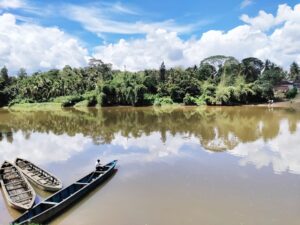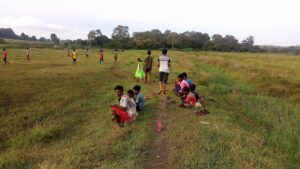The project plans to utilise the Cauvery Water Disputes Tribunal's allocated water share, but it raises environmental concerns in Wayanad.

A view of Kadamanthodu, which contributes to Kabani. (South First/ K A Shaji)
Almost two decades ago, the Cauvery Water Disputes Tribunal (CWDT) awarded Kerala a 30 TMC share of water, including 21 TMC from the Kabani river basin in the northern district of Wayanad.
The state, however, is yet to use this resource in any form.
The allocated water continues to flow into Karnataka and Tamil Nadu via the eastward-flowing rivers of Kabani, Bhavani, and Pambar, and this water is part of the currently disputed amounts between the two neighbouring states.
The Kabani is the largest of Kerala’s three eastward-flowing rivers that join the Cauvery. It has a total length of 210 km. Some 56 km of this river runs through Wayanad.
When the Oommen Chandy-led UDF government was in office, an attempt was made to build a small dam on the Shiruvani river — a tributary of the Bhavani that eventually joins the Cauvery in Tamil Nadu — in the tribal hinterlands of Attappadi.
When a survey was launched in this regard, the Tamil Nadu government, and farmers in the downstream Coimbatore-Tirupur-Erode region were up in arms.
As a result, the project was halted.

The inter-state Kabani river at Perikkallur near Pulpally. (South First/K A Shaji)
The second Pinarayi Vijayan government is now resurrecting the long-dormant Kadamanthodu Irrigation and Drinking Water Project in order to use at least a portion of the state’s allocated share of Cauvery water.
The Pulpally and Mullankolli village panchayats in Wayanad, through which the Kabani river passes, have been experiencing severe drought for the past several years, and the government is proposing the project as a permanent solution to the region’s water woes.
Pulpally-Mullankolly, also one of Kerala’s coffee and black pepper hubs, has a drinking water problem as well.
Last week, a high-level government delegation led by additional chief secretary Ashok Kumar Singh toured the possible dam site, and, at Pulpally, it convened an all-party conference to help lay the basis for the project.
A Delhi-based company has already been tasked with performing a Lidar (Light Detection and Ranging) survey to collect 3D data over the project area.
The aerial and land surveys will begin as soon as possible, officials told South First.
The state government believes that because the project will only use a portion of the tribunal’s grant, it will face great opposition from Karnataka and Tamil Nadu.
The initiative, however, is facing fierce criticism not only from environmentalists in Kerala, but also from residents in Wayanad on the ground that it will lead to displacement of people and also ruin of verdant forests.
The opposition derives from the fact that, if completed, the project will compel many people to relocate from heavily-populated areas chosen by officials as suitable for the dam’s construction.
According to environmentalists, damming the stream Kadaman, a main feeder of the Kabani river, could cause a multitude of environmental and socio-economic concerns, as well as jeopardise the safety of wild animals and plants in the pristine Wayanad Wildlife Sanctuary.
“The proposed dam will be a white elephant, costing the state exchequer money while delivering no benefit to farmers. The project’s completion could take at least a half-century. Until then, if the drought continues, Wayanad will become a desert,” said N Badusha, president of the Wayanad Prakrithi Samithy, an environmental protection forum.
“The government must extend irrigation and drinking water supply to Pulpally and Mullankolli by laying pipelines from the now-unused storages in the Karapuzha dam, which was built over a long period of time and at great expense,” Badusha told South First.
However, the ruling CPI(M)-led LDF is aggressively pushing for the resumption of this long-stalled project, arguing that the drought-like conditions and scarcity of drinkable water have greatly reduced the local community’s opposition to the project.
The party has already launched a public relations campaign in which it claims that the project is the only solution to water scarcity.
Highly placed insiders in Kerala’s Irrigation Department confirmed the scheme’s rebirth to South First, but added that there is another strange reason for the initiative’s resumption.
Aside from the Cauvery Tribunal and a scarcity of potable water, the department is pushing the dam as a way to prevent Wayanad from future flood-related adversities.
The draught-like situation in the region apart, for over a decade now, annual floods are also a big concern in Wayanad.
According to officials, research by the Kerala State Remote Sensing and Environment Centre would be used to develop a feasibility report for the Kadamanthodu Irrigation Project and the under-consideration Thondar Project.
This report, stating ground realities, will be delivered to the Central Water Commission for ratification soon.
The state anticipates that the Union government will not object to the Kadamanthodu project because it falls within the Cauvery Tribunal’s water restriction.
A dam with a height of 28 metres and a width of 490 metres is being designed.
Apart from reducing water scarcity in the Pulpally-Mullankolli region, the project’s intended goal is to irrigate 1,940 hectares of agricultural land.
According to officials, the project’s ground-level investigative studies would begin as soon as the Central Water Commission accepts the feasibility report.
They claim that the project will only consume 0.52 TMC of the total water granted and will not cause conflicts with adjacent states.
The Banasura Sagar dam and the Karapuzha Irrigation Project are the only projects in Wayanad that address drinking water, irrigation, and flood-control demands at present.
Interestingly, Kadamanthodu is not the only project proposed by the Kerala government in the Kabani basin.
Similar initiatives on additional Kabani river basin feeders such as Noolpuzha, Thirunelli, Kallampati, Chengat, and Peringotupuzha are in the works, and each of them raises the prospect of significant environmental harm and displacement.
Water from the Kadaman stream currently flows into the Beechanahalli dam in Karnataka, where it meets the agricultural needs of the locals.
“While the Karnataka government’s Beechanahalli dam, built at a cost of ₹390 crore, is irrigating 45,729 hectares, supporting two power plants, and providing drinking water to Mysuru and Bengaluru, the farmlands of Mullankolli and Pulpally panchayats, which are crisscrossed by the Kabani river, are drying up due to severe drought,” said CPI (M) district secretary P Gagarin, who opines that the project should be started.
“Drought and water scarcity have been problems in Wayanad since 2004. Pulpally, which used to produce 2,000 metric tonnes of pepper per year, can now only produce about 200 metric tonnes,” Gagarin told South First.
Farmers in the region, he claims, have long abandoned paddy planting due to a lack of sufficient irrigation.
According to officials, the proposed dam would be located in Pulpally Panchayat’s Palakolli village. The reservoir is expected to submerge surrounding densely-populated villages such as Anapara, as well as large areas of the towns of Pulpally and Mullankolli.

Children play on the Kabani banks at the Kerala-Karnataka border in Mullankolly. (South First/K A Shaji)
The proposed dam will have a catchment area of 4,779.7 hectares, a bay level of 728 metres, and a storage capacity of 14.62 million cubic metres.
The dam proposes piping water to agricultural areas rather than open canals. According to officials, as a result, the cost of purchasing land may be reduced.
Pipes will be installed along highways and river banks whenever possible.
Sprinkler and drip irrigation systems are also advised to minimise water waste and maximise water consumption.
The Kadaman stream runs through Pulpally town and Mullankolli panchayat for 20 km before joining the Chempakamula and Mudikode streams, and later the Kabani river at the Karnataka border.
Arecanut, pepper, coffee, banana, coconut, and other crops have been hand-cultivated on both stream banks.

May 15, 2024

May 15, 2024

May 15, 2024

May 15, 2024

May 14, 2024

May 14, 2024